![]()
![]()
![]()
Use LEFT and RIGHT arrow keys to navigate between flashcards;
Use UP and DOWN arrow keys to flip the card;
H to show hint;
A reads text to speech;
65 Cards in this Set
- Front
- Back
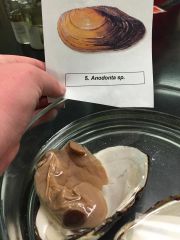
|
kingdom: animalia phylum: mollusca Class: bivalvia genus: Anodonta Common Name: Clam |
|
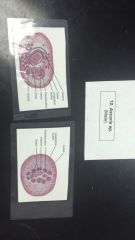
|
kingdom: animalia phylum: nematode genus: Ascaris common name: roundworm |
|
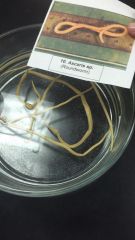
|
kingdom phylum: nematode genus: ascaris common name: roundworm |
|
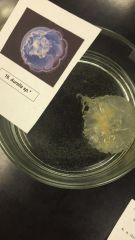
|
kingdom: animalia phylum: cnidarian class: Scyphozoa genus: aurelia Common name: Moon Jelly |
|
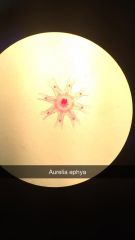
|
kingdom: animalia phylum: cnidarian class: scyphozoa species: aurelia ephya |
|

|
kingdom: animal phylum: cnidarian class: scyphozoa genus: aurelia (larvae) |
|
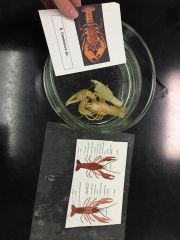
|
kingdom: phylum: arthropoda subphylum/Class: crustacea genus: cambarus Common Name: Crayfish
|
|
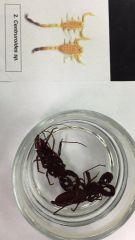
|
kingdom: animalia phylum: arthropoda subphylum: arachnida Common Name: scorpion
|
|
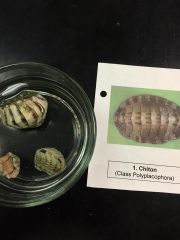
|
kingdom: animalia phylum: mollusca class: polyplacadora Common Name: chiton |
|
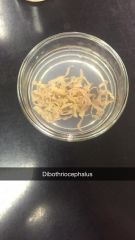
|
kingdom: animalia phylum: platyhelminthes Class: cestoda Common Name: tapeworm |
|
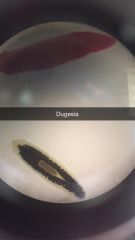
|
kingdom phylum: Platyhelminthes class: Turbellaria genus: dugesia Common Name: Planaria |
|

|
kingdom phylum: Platyhelminthes Class: Trematoda genus: fasciolapsis Common Name: liver fluke |
|
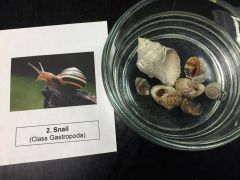
|
kingdom phylum: Mollusca class: gastropoda Common Name: snail |
|
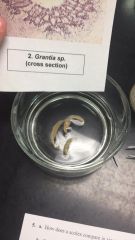
|
kingdom: phylum: porifera genus: grantia |
|

|
kingdom: animalia phylum: annelida class: hirudinea Common name: leech |
|
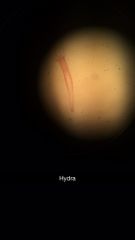
|
kingdom phylum: cnidarian Class: hydrozoa genus: hydra |
|
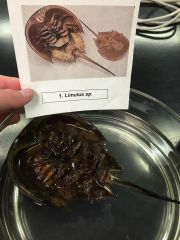
|
kingdom: animalia phylum: arthropoda class: merostomata genus: limulus Common Name: Horseshoe crab |
|
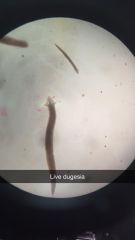
|
kingdom phylum: platyhelminthes class: Turbellaria genus: dugesia (live) |
|

|
kingdom phylum: mollusca class: cephalopoda genus: loligo Common Name: Squid |
|
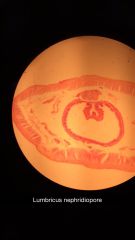
|
kingdom phylum: annelida Class: Oligochaeta genus: lumbricus Common Name: earthworm
|
|
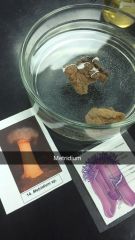
|
kingdom phylum: cnidarian class: anothozoa genus: metridium Common Name: anemone |
|
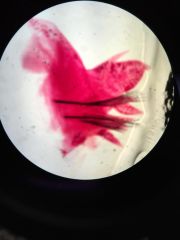
|
kingdom phylum: annelida class: polychaeta genus: nereis Common Name: Marine Worm |
|

|
kingdom phylum: annelida class: polychaeta genus: nereis Common Name: Marine Worm |
|
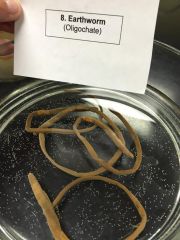
|
kingdom phylum: annelida Class: oligochaeta Genus: Lumbricus Common Name: earthworm |
|
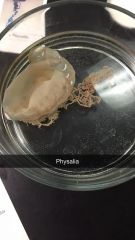
|
kingdom phylum: cnidarian class: hydrozoa genus: physalia common name: Portuguese man-of-war |
|
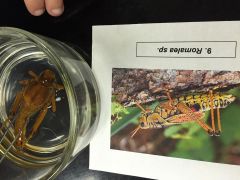
|
kingdom phylum: arthropoda class: insecta genus: romalea Common Name: grasshopper |
|

|
kingdom phylum: arthropoda Class: Chilopoda genus: scolopendra Common Name: centipede |
|
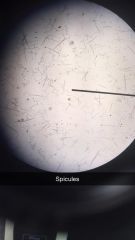
|
kingdom phylum: porifera -spicules give the sponge rough structure |
|
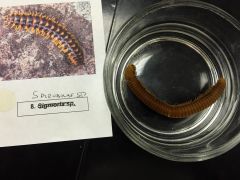
|
kingdom phylum: arthropoda class: diplopoda genus: sigmoria Common Name: Millipede |
|
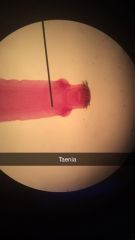
|
kingdom phylum: platyhelminthes Class: cestoda genus: taenia |
|
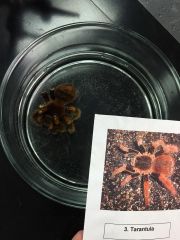
|
kingdom phylum: arthropoda Class: Arachnida Common Name: tarantula
|
|
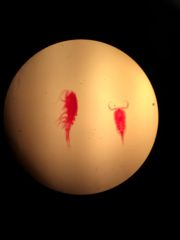
|
kingdom phylum: small crustaceans |
|

|
kingdom phylum: nematoda genus: turbatrix Common Name: Vinegar Eel |
|
|
the 5 characteristics of Chordates are ___. |
A notochord, pharyngeal pouches, a dorsal tubular nerve cord, and a postanal tail are all present at some time in the life history. |
|
|
what is a notochord? |
a dorsal supporting rod extending the length of the body. The notochord is replaced during development by a vertebral column in the vertebrates |
|
|
what is a dorsal tubular nerve cord? |
In vertebrates, the nerve cord, more often called the spinal cord, is protected by the vertebrae. |
|
|
Pharyngeal pouches develop into ___. |
fuctioning gills in the invertebrate chordates, the fishes, and amphibian larvae. In terrestrial animals, the pouches are modified for various other functions. |
|
|
What is a post–anal tail? |
a tail that extends beyond the anus |
|
|
Subphylum Urochordata contains?? |
tunicates, or sea squirts. |
|
|
Subphylum Cephalochordata contains??? |
Lancelets are small fishlike animals that occur in shallow marine waters in most parts of the world. |
|
|
Characteristics of Vertebrates |
are segmented, and specialization of parts has occurred. two pairs of appendages. The vertebrate brain is more complex than that of arthropods and enclosed by a skull. A high degree of cephalization. All organ systems are present and efficient. |
|
|
The 7 classes of Vertebrates are ___. |
SUBPHYLUM VERTEBRATE Class Reptilia Class Aves Class Agnatha Class Mammalia |
|
|
Class Chondrichthyes contains??? |
Marine cartilaginous fishes; lack swim bladder; tail fin usually asymmetrical
sharks, skates, and rays |
|
|
Class Osteichthyes contains?? |
Marine and freshwater bony fishes; swim bladder or lungs; tail fin usually symmetrical lungfishes, lobe–finned fishes, and ray–finned fishes (herring, salmon, sturgeon, eels, sea horse) |
|
|
Class Amphibia contains/characteristics?? |
tetrapod with non-amniotic egg; nonscaly skin; some show metamorphosis; ectothermic
urodeles (salamanders,newts) and anurans (frogs, toads) |
|
|
Class Reptilia contains/characteristics? |
Tetrapod with amniotic egg; scaly skin; extothermic
squamata (snakes,lizards) chelonians (turtles,tortoises) |
|
|
Class Aves contains/characteristics?? |
Tetrapod with feathers; bipedal with wings; endothermic
sparrows,penguins and ostriches |
|
|
Class Mammalia contains/characteristics? |
Tetrapods with hair, mammary glands; endothermic
monotremes (spiny anteater, duckbill platypus), marsupials (opossum,kangaroo), and placental mammals (whales, rodents, dogs,cats,elephants,horses,bats,humans) |
|
|
Class Polychaeta contains??? |
marine annelids |
|
|
Class Hirudinea contains/characteristics??? |
Leeches. |
|
|
Class Oligochaeta contains/means??? |
Earthworms and freshwater worms. |
|
|
Phylum Arthropoda have what kind of skeleton? |
Exoskeleton |
|
|
what are Chelicerae? |
First pair of appendages, used to grab food and **** |
|
|
Class Arachnida characteristics?? |
Have simple eyes, no antennae, and no jaws and spinnerets |
|
|
Class Merostomata contains/characteristics?? |
Horseshoe crab. spine–like tails. |
|
|
Class Chilopoda contains/characteristics?? |
Centipedes. |
|
|
Class Diplopoda contains/characteristics?? |
Millipedes, vegetarians. Two pairs of legs |
|
|
the Class Crustacea contains? |
Lobsters, crayhfish, crabs, and shrimp. |
|
|
characteristics of Class Insecta |
Three different body regions, 6 walking legs, and one or two pairs of wings. |
|
|
characteristics of Phylum Echinodermata |
Spiny–skinned, marine animals characterized by pentaradial symmetry. Multiples of five arranged in a radial pattern. |
|
|
Class Asteroidea contains??? |
Sea stars and starfishes. |
|
|
Class Crinoidea contains??? |
Sea lilies. |
|
|
Class Echinoidea contains??? |
Sea urchins and sand dollars. Moveable spines. |
|
|
Class Holothuroidea contains??? |
Sea cucumbers. Cylindrical body with no arms or spines. |
|
|
Class Ophiuroidea contains??? |
Brittle stars. Five slender, jointed arms attached to small central disk |

